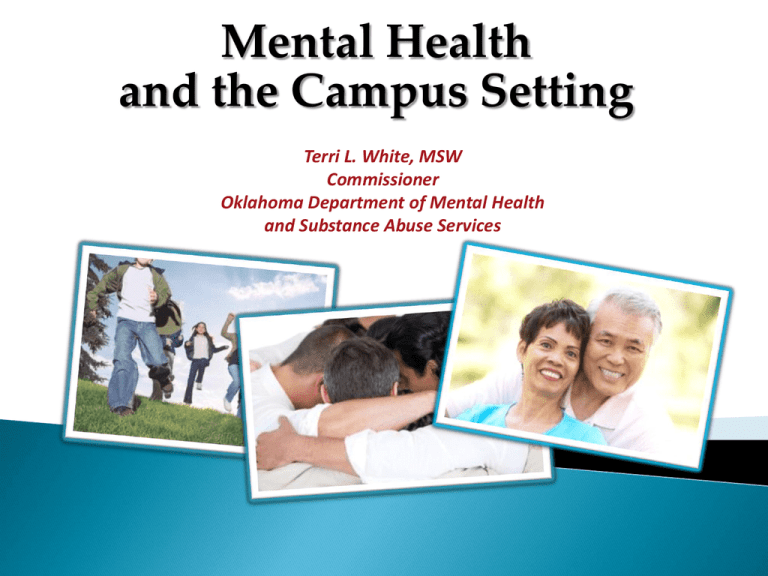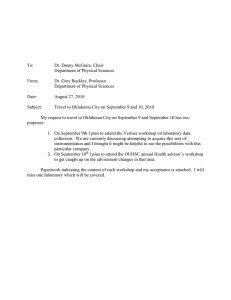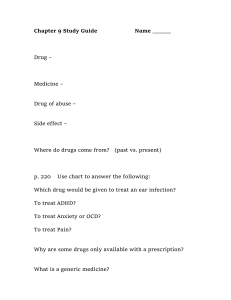Mental Health and the Campus Setting Terri L. White, MSW Commissioner
advertisement

Mental Health and the Campus Setting Terri L. White, MSW Commissioner Oklahoma Department of Mental Health and Substance Abuse Services Higher education students and their families increasingly look to college and universities to provide mental health and behavioral health services for their students, thus leading to a growing demand for supportive services on college campuses. Tragic events such the Virginia Tech shooting underscore the necessity to address the significant increase in the mental health needs of this population. Understanding the best practices for behavioral health services in colleges and universities is a crucial step in establishing the necessary comprehensive campus-wide approach to address the multifaceted needs of college and university students. The college experience is not isolated to the classroom; therefore, colleges and universities are called upon to shift and expand their priorities to address the behavioral health needs of a diverse student population. 2 Both mental illness and addiction are real medical conditions, just like diabetes, cardiovascular disease and heart disease. In terms of addiction, although initial substance use might be voluntary, drugs of abuse have been shown to alter gene expression and brain circuitry, which in turn affect human behavior. Once addiction develops, these brain changes interfere with an individual’s ability to make voluntary decisions, leading to compulsive substance abuse, seeking and use. (Natl. Institute on Drug Abuse) 3 The brain scan on the left reflects normal activity; the scan on the right shows a person affected with schizophrenia. Source: PBS.org 4 5 In March, SAMHSA released a national report showing Oklahoma ranks second nationally in prevalence rates of both “serious” mental illness and “any” mental illness among adults over age 18. This represents more than 630,000 adults, and doesn’t include children and those with substance abuse issues. 6 In Oklahoma, mental disorders are the third leading cause of chronic disease – behind only pulmonary conditions and hypertension – and more prevalent than heart disease, diabetes, cancer and stroke. More than 245,000 Oklahomans above the age of 12 abuse or are dependent on alcohol or illicit drugs; and underage drinkers consume just over 20% of all alcohol sold in Oklahoma. 10% of youth have a mental illness; an additional 10% have substance abuse issues. Deaths due to suicide are increasing, jumping from 567 in 2009 to 618 in 2010. Oklahoma ranks 13th nationally in terms of suicide rate. Between 1-3% of all Oklahomans are problem or compulsive gamblers and in need of intervention. In 2010, Oklahoma had the 4th-highest unintentional overdose death rate in the nation (17.9 deaths per 100,000 population). 7 In 2010, 618 Oklahomans died by suicide, up from 567 in 2009. Oklahoma ranks 13th nationally in terms of suicide rate. Suicide continues to be the most common manner of violent death in Oklahoma. For ages 15-34, suicide is the second leading cause of death in Oklahoma. the Suicide rates in rural counties are generally higher than rates in urban counties. The rate increased 10% in rural counties and 7% in urban counties from 2004-2009. Oklahoma Violent Death Reporting System, 2004-2010 8 Mental, emotional, and behavioral (MEB) disorders are a major health threat and are as commonplace today among young people as a fractured limb – not inevitable, but not at all unusual. One in five young people have one or more MEB disorders at any given time. Half of all mental illnesses occur by age 14 and 75% by age 24. Clear windows of opportunity are available to prevent MEB disorders and related problems before they occur. Risk factors are well established, preventive interventions are available, and the first symptoms typically precede a disorder by two to four years. 9 20% of college students experience a mental illness, and increasing numbers of students arrive on campus having received mental health services prior to starting their college careers. (Suicide Prevention Resource Center) More than 50% of college students experienced "overwhelming anxiety" at some point in the past year, 32% reported feeling "so depressed that it was difficult to function", and 8% reported seriously considering suicide. (American College Health Association, 2013) In addition, alcohol and substance abuse are major issues on college campuses. Half of all full-time college students binge drink, abuse prescription drugs and/or illegal drugs, and almost 1 in 4 of the nation’s college students (22.9%) meet the medical criteria for substance abuse or dependence. (The National Center on Addiction and Substance Abuse at Columbia University) Of the approximately 20% of students who had been diagnosed or treated for a mental health or substance use condition in the past year, the most common conditions were depression, anxiety, panic attacks and ADHD. (ACHA, 2011) 10 Prevention Recommendations: Mental Health Training School-Based Prevention/Screening Mental health is not well understood by the general public or even among certain professionals who interact with populations at risk. The vast majority of people with a mental illness are NOT violent. Serious mental illness contributes very little to the overall rate of violence in the general population; an estimated 3-5% - much lower than that associated with substance abuse. (In fact, people with no mental disorder who abuse alcohol or drugs are nearly seven times as likely as those without substance abuse to commit violent acts.) Better identification of mental health risk factors or warning signs prior to or at the first onset of first symptoms can aid in averting the development or escalation of more serious illness or problems. Primary care providers and school personnel must be trained on this essential information. 8 Mental Health First Aid MHFA is an evidence-based training program that trains school personnel to recognize signs of mental illness and substance use within the student population so they can intervene early to prevent a crisis or act to de-escalate a crisis once one develops. Course participants gain the skills, resources and knowledge necessary to help an individual in crisis connect with appropriate professional, peer, social, and self-help care. ODMHSAS recently launched a pilot project making an eight-hour training available for K-12 teachers, administrators and staff at school districts across the state upon their request. It is now available to Oklahoma colleges and universities upon request. MHFA provides an ideal forum to engage groups in discussing the signs and symptoms of mental illness, the prevalence of mental health disorders, the effectiveness of treatment and how to engage troubled young people in services. For more information, call Dane Libart at (405) 522-1440. 16 School-based screening can help prevent the development of psychological and behavioral problems, which interfere with school performance. The Institute of Medicine recommends universal screening procedures be targeted for the purpose of: Improving school success with struggling students Preventing bullying and student harassment Improving teacher and peer relationships Increasing school safety and security, or Learning to regulate and control behavior 14 Suicide Prevention ODMHSAS contracts with the State Regents to provide behavioral health screenings on campuses, with an emphasis on suicidal ideationrelated questioning. The accord also involves increasing “Question. Persuade. Refer.” gatekeeper trainings. Key gatekeepers include a variety of college personnel who are in a position to recognize the warning signs that someone may be contemplating suicide. ODMHSAS also will be launching the JED Healthy Campus Certification across Oklahoma. JED is an evidence-based behavioral health/ substance abuse survey and rating similar to a healthy business designation, which allows prospective students and families to quickly assess what types of behavioral health and substance abuse services will be available to them during their time at school. http://www.jedcampus.org/learn-about-jedcampus 15 AlcoholEdu AlcoholEdu is an evidence-based alcohol prevention program available to all Oklahoma high schools at no cost through a partnership between the ODMHSAS and the Oklahoma Department of Education. 19% of Oklahoma youth report that they had their first drink of alcohol, other than a few sips, before the age of 13. (YRBS, 2011) 74% of 12th graders have used alcohol. (OPNA, 2010) AlcoholEdu has been shown to increase alcoholrelated knowledge, undermine acceptance of underage drinking, reduce underage drinking, and reduce riding with an intoxicated driver. 16 Screening for Depression and Suicide Within the Primary Care Setting Training providers to recognize and treat depression decreases suicidal ideation and completed suicides in patients. It is essential to screen for suicidality if there is any suspicion that a patient might be suicidal. Screening tools such as the nine-item scale of the Patient Health Questionnaire (the PHQ-9) can be an effective and time-efficient way to screen patients. The PHQ-9 is based directly on the diagnostic criteria for major depressive disorder in the Diagnostic and Statistical Manual Fourth Edition (DSM-IV). These screenings can be conducted in a campus health-clinic setting, and patients who need more extensive treatment receive referrals to specialty care. For more information: 1-877-724-7865. 14 Brief Alcohol Screening and Intervention for College Students (BASICS) BASICS is a prevention program for college students who drink alcohol heavily and have experienced, or are at risk for, alcohol-related problems. Following a harm reduction approach, BASICS aims to motivate students to reduce alcohol use in order to decrease the negative consequences of drinking. It is delivered over the course of two 1-hour interviews. Based on principles of motivational interviewing, BASICS is delivered in an empathetic, non-confrontational, nonjudgmental manner, and is aimed at revealing the discrepancy between the student's risky drinking behavior and his or her goals and values. The intervention is delivered by trained personnel. Studies show that students receiving BASICS had significantly greater reductions in drinking frequency over the first 2-year period than students in the no-treatment control group, with the greatest impact between baseline and 6-month follow-up and 1-year follow-up. The intervention group also reported drinking significantly less frequently at 1-year follow-up than the control group. For more information: 1-877-724-7865. 15 Treatment Works The good news is this: TREATMENT WORKS! Mental illness and addiction can be diagnosed and effectively treated. In some instances they are preventable. The sooner a mental or addictive disorder is diagnosed and treated, the better the outcome is for all involved, just as is the case with diabetes, cancer or heart disease when diagnosed early. Success rates for heart disease treatments range from 41-52%. The treatment success rate for schizophrenia is 60%. More than 80% of people with depression can be treated successfully with medications, psychotherapy or both. Substance abuse treatment has similar positive outcomes if people can access appropriate treatment and follow-up care. 19 Treatment Works In FY13, ODMHSAS provided services to approximately 80,000 individuals. Nearly 64,000 received mental health services and 19,000 received substance abuse treatment services, with some overlap. ODMHSAS programs have been proven to help people: Reunite with their families Increase employment prospects and monthly income Stay out of jail/reduce involvement with the criminal justice system Reduce homelessness Break the cycle of addiction Achieve numerous other successful outcomes, such as obtaining higher educations, increasing productivity on the job, stopping tobacco use, etc. 20 Conclusion To be successful, any discussion about increasing school safety must address the issue of mental health. As nearly half of all lifetime mental illnesses start by age 14, the importance of prevention and early intervention cannot be overstated. Just as we screen our young people for asthma and other physical illnesses, we also must screen them for such illnesses as depression, anxiety or other behavioral health issues. The sooner a mental or addictive disorder is diagnosed and treated, the better the outcome is for all involved, just as is the case with diabetes, cancer or heart disease when Website: diagnosed early. www.odmhsas.org Facebook: The good news is that help and there is hope. www.facebook.com/ODMHSAS Twitter: @ODMHSASINFO 21




